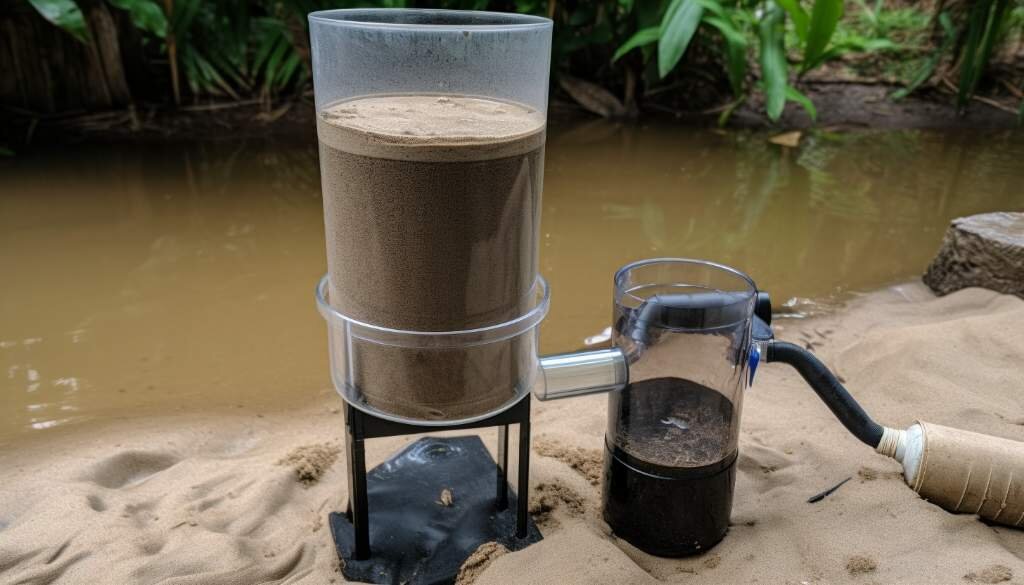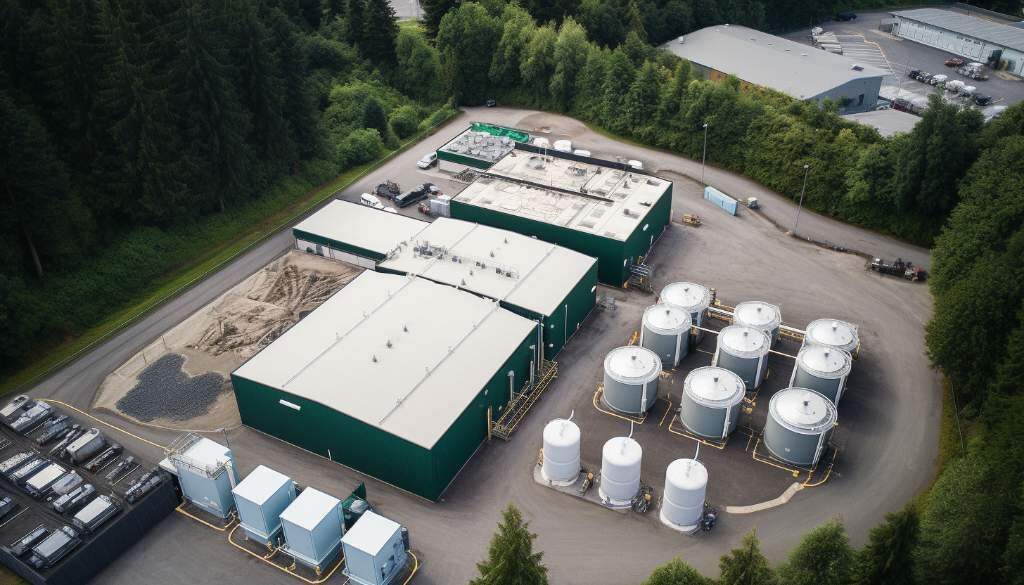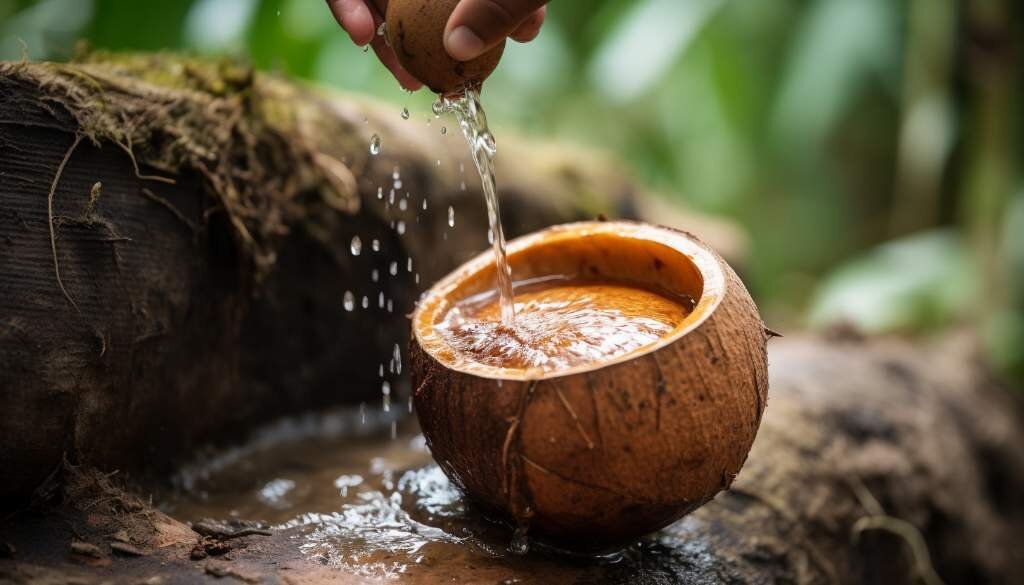
Introduction to Natural Water Filters
Natural water filters play a crucial role in ensuring that our water is clean and safe for consumption. These filters rely on natural processes to remove unwanted particles and impurities from water sources, making them an effective and environmentally-friendly solution to water purification.
In the following sections, we will explore the various types of natural water filters available, including Wisewell's natural water filters, tree branch filters, plant purification plants, and subsurface dams. We will also delve into the concept of artificial groundwater recharge and water management, discussing the sustainable solution it provides for water purification and the advantages of bank filtration.
Furthermore, we will examine the process of natural water purification, starting with pre-filtration as the initial step. We will then dive into the details of bank filtration, highlighting its importance and effectiveness. Finally, we will explore the plant purification process and how it contributes to cleaner water.
If you are interested in purifying water naturally at home, we will provide you with simple DIY methods for creating your own natural water filters. Additionally, we will discuss the benefits of using natural water filters for home use.
Stay tuned for an in-depth exploration of the science behind natural water filters, how they work, and the numerous benefits they offer for clean and healthy water.
Understanding the Need for Clean Water
Understanding the need for clean water is crucial in recognizing the importance of natural water filters in our daily lives. Water is an essential resource for all living beings, and clean water is vital for maintaining our health and well-being.
Unfortunately, many sources of water, such as rivers, lakes, and groundwater, can be contaminated with various pollutants. These pollutants can include bacteria, viruses, chemicals, heavy metals, sediment, and other harmful substances.
Consuming contaminated water can lead to waterborne diseases and other health problems. This is why the need for clean water cannot be overstated, especially in areas where access to safe drinking water is limited.
Natural water filters play a crucial role in removing unwanted particles and impurities from water, making it safe for consumption. By understanding the need for clean water, we can appreciate the importance of natural water filters in providing us with clean and healthy water.
How Natural Water Filters Remove Unwanted Particles
Natural water filters utilize various mechanisms to effectively remove unwanted particles and contaminants from water sources. These filters employ natural materials and processes to ensure the purification of water. Here are some ways in which natural water filters remove unwanted particles:
- Physical Filtration: Natural water filters use physical barriers to trap and filter out impurities. The filter media, which can be composed of materials like sand, gravel, or activated carbon, acts as a physical barrier that captures larger particles such as sediment, dirt, debris, and even some microorganisms. As the water passes through the filter, these unwanted particles are retained, resulting in cleaner water.
- Adsorption: Adsorption is the process in which impurities and contaminants are attracted to the surface of the filter media. Activated carbon is highly effective in adsorbing organic compounds, chlorine, and some heavy metals. The porous structure of activated carbon provides a large surface area for impurities to adhere to, effectively removing them from the water.
- Ion Exchange: Natural water filters may also utilize ion exchange processes to remove unwanted ions from the water. Ion exchange materials, such as zeolite, exchange certain ions in the water with other ions in the filter media. This process can effectively remove minerals like calcium, magnesium, and iron, which can cause hardness and contribute to scale buildup in water systems.
- Biological Filtration: Some natural water filters rely on the action of beneficial microorganisms to remove impurities. For example, biofilters use a bed of microorganisms to break down organic matter, such as ammonia and nitrates, through a process known as nitrification. These microorganisms convert harmful substances into less harmful compounds, improving the quality of the water.
- Chemical Filtration: Natural water filters may employ chemical reactions to remove specific contaminants. For instance, filters containing granular limestone or crushed coral can help raise the pH of acidic water by neutralizing excess acidity. This type of filtration is particularly useful in areas where acidic water can cause corrosion or other water quality issues.
Natural water filters are versatile and can effectively remove a wide range of unwanted particles and contaminants. By combining different filtration mechanisms, these filters provide a comprehensive purification process that results in cleaner, healthier water for various applications.

Types of Natural Water Filters
Natural water filters are a type of filtration system that use natural materials and processes to remove impurities and contaminants from water sources. These filters are often used as an alternative to traditional water treatment methods, providing a more environmentally friendly and sustainable solution.
In this section, we will explore different types of natural water filters and their unique features. We will discuss Wisewell's natural water filters, which utilize advanced technologies to achieve efficient filtration. We will also explore tree branch filters, which harness the natural filtering properties of tree branches to remove unwanted particles from water.
Another type of natural water filter is plant purification plants. These plants effectively filter water by utilizing the natural abilities of certain plant species to absorb and remove contaminants. Lastly, we will look at subsurface dams, which are constructed underground to filter water as it flows through porous materials.
Each type of natural water filter has distinct benefits and considerations. In the following sections, we will delve deeper into each topic, explore the mechanisms behind their filtration processes, and discuss their effectiveness in purifying water sources.
Continue reading to learn more about these fascinating natural water filters and how they can contribute to cleaner and healthier water sources.
Wisewell's Natural Water Filters
Wisewell's Natural Water Filters are one of the most effective and innovative types of natural water filters available in the market today. These filters are designed to remove contaminants and impurities from water, ensuring that you get safe and clean drinking water.
What sets Wisewell's Natural Water Filters apart is their unique combination of filtration materials and technologies. The filters are made with a blend of natural elements, such as activated carbon, ceramic, and KDF media.
Activated carbon is a highly porous material that has the ability to trap and remove various organic compounds, chemicals, and pollutants from water. It can effectively remove chlorine, pesticides, herbicides, and other harmful substances.
Ceramic, on the other hand, acts as a physical barrier, trapping particles and bacteria, and preventing them from passing through. It removes sediments, rust, and other visible impurities.
KDF media is a mixture of copper and zinc alloys that not only inhibits the growth of bacteria, algae, and fungi but also removes heavy metals, like lead and mercury, from water. It also helps to neutralize chlorine and other harmful chemicals.
Wisewell's Natural Water Filters are designed to be user-friendly and easy to install. They come in various sizes and configurations to fit different household needs. Some models can be conveniently attached to faucets or water dispensers, while others can be installed under the sink or integrated into existing plumbing systems.
Aside from their superior filtration capabilities, Wisewell's Natural Water Filters are also known for their long-lasting performance. The filters have a high dirt-holding capacity and can purify a significant amount of water before needing replacement. This makes them a cost-effective and sustainable choice for water filtration.
In conclusion, Wisewell's Natural Water Filters are an excellent option for those who prioritize clean and safe drinking water. With their unique combination of advanced filtration materials and technologies, these filters effectively remove contaminants and impurities, ensuring that you and your family can enjoy pure and healthy water every day.
Tree Branch Filters
Tree branch filters are a type of natural water filter that can effectively remove impurities from water. They work by utilizing the natural filtration properties of tree branches, which act as a barrier to trap unwanted particles and contaminants.
To create a tree branch filter, you will need a large container, such as a barrel or bucket, that can hold water. Start by selecting sturdy tree branches that are free from any chemicals or pests. The branches should be long enough to reach from the bottom of the container to the top.
Next, place the branches vertically in the container, ensuring that they are tightly packed. This creates a natural filtration system, where the water passes through the branches, allowing them to capture debris, sediment, and other impurities.
As the water flows through the tree branches, it undergoes a process called adsorption. This is when the impurities in the water adhere to the surface of the tree branches, effectively removing them from the water. The tree branches act as a physical barrier, preventing larger particles from passing through and providing a cleaner water supply.
It is important to note that tree branch filters are not a complete replacement for other water purification methods. While they can effectively remove some impurities, they may not be able to eliminate certain harmful bacteria or viruses. Therefore, it is recommended to use tree branch filters in conjunction with other water treatment methods, such as boiling or chemical disinfection, to ensure safe drinking water.
Tree branch filters are a cost-effective and environmentally friendly option for water filtration. They are relatively easy to set up and maintain, making them suitable for both rural and urban areas. Additionally, they can be used for both personal and community-level water purification.
In conclusion, tree branch filters are an innovative type of natural water filter that utilizes the filtration properties of tree branches to remove impurities from water. While they may not provide complete water purification, they can effectively eliminate debris and sediment, making the water cleaner. By combining tree branch filters with other water treatment methods, you can ensure a safe and reliable drinking water supply.
Plant Purification Plants
Plant purification plants are a type of natural water filter that utilizes various types of plants to remove impurities from water sources. These plants are typically aquatic or semi-aquatic species that have the ability to absorb and eliminate contaminants through a process called phytoremediation.
Phytoremediation is the natural ability of certain plants to remove, detoxify, and/or immobilize contaminants in the soil, water, or air. These plants are commonly referred to as hyperaccumulators. They have the unique ability to absorb and store high concentrations of toxic substances without being harmed.
When used for water purification, plant purification plants are typically constructed in wetland areas or designated zones where the contaminated water can flow or be pumped through. The process involves specific types of plants being strategically planted in a carefully designed system.
As the contaminated water passes through the plant purification plants, the plants absorb the pollutants, including heavy metals, organic compounds, and other contaminants. The contaminants are then broken down or rendered harmless by the plants through various mechanisms.
One mechanism involves the plants, particularly the roots, secreting enzymes, acids, or other substances that can either help break down the contaminants or neutralize their toxicity. Another mechanism involves the plants absorbing the contaminants and storing them in their tissues, effectively removing them from the water.
The effectiveness of plant purification plants in removing specific contaminants depends on the species of plants used and the type of contaminants present in the water. Some plants are more effective at removing heavy metals, while others are better at removing organic compounds.
Plant purification plants offer several advantages as a natural water filtering method. They are environmentally friendly, as they do not require the use of chemicals or energy-intensive processes. They can be cost-effective compared to other types of water filtration systems, especially in areas where plants naturally grow and can be easily cultivated.
Additionally, plant purification plants provide habitat and food for certain species of wildlife, helping to promote biodiversity in aquatic ecosystems. They can also act as natural buffers, preventing erosion and maintaining the stability of riverbanks and wetland areas.
Overall, plant purification plants are a sustainable and effective method of natural water filtration. By harnessing the power of plants and their phytoremediation abilities, these plants help restore and maintain the quality of our water sources, ensuring clean and safe water for both humans and the environment.
Subsurface Dams
Subsurface dams are a type of natural water filter that can effectively remove unwanted particles from water sources. These dams are constructed underground and are designed to slow down the flow of water, allowing sediment and other impurities to settle.
One of the main advantages of subsurface dams is that they are environmentally friendly and do not require any chemicals or energy to operate. They rely on the natural filtration properties of the soil and groundwater to purify the water.
When water passes through a subsurface dam, the particles and impurities in the water settle out due to the reduced flow velocity. This process is called sedimentation. The sedimentation of particles helps to remove larger impurities such as sand, silt, and clay.
Additionally, subsurface dams also act as a physical barrier for the movement of contaminants from polluted areas to clean groundwater sources. They can prevent pollutants such as industrial waste, fertilizers, and pesticides from infiltrating the groundwater.
The effectiveness of subsurface dams as a natural water filter is dependent on factors such as the type of soil, the depth of the dam, and the flow rate of water. The soil acts as a natural filter, trapping impurities and allowing cleaner water to pass through.
In some cases, subsurface dams can also recharge underground aquifers, replenishing the groundwater supply. This helps in maintaining a sustainable water source and mitigating the effects of drought.
Overall, subsurface dams are an innovative and effective method of natural water filtration. They provide a cost-effective and sustainable solution for purifying water, making it safe for consumption and other uses.

Artificial Groundwater Recharge and Water Management
Artificial groundwater recharge and water management is a crucial aspect of ensuring a sustainable water supply. It involves developing and implementing strategies to replenish underground water sources artificially and efficiently manage this vital resource.
In the following sub-sections, we will briefly discuss various aspects of artificial groundwater recharge and water management without going into specific details.
- A Sustainable Solution for Water Purification
- The Role of Artificial Aquifers
- Advantages of Bank Filtration
A Sustainable Solution for Water Purification
Artificial groundwater recharge is a sustainable solution for water purification that has gained significant attention in recent years. With growing concerns about water scarcity and pollution, it has become crucial to explore methods that can help replenish and purify our water sources.
Artificial aquifers play a key role in this process. They are created by injecting treated wastewater or surface water into underground geological formations. The water is allowed to slowly infiltrate through the soil and rock layers, undergoing a natural filtration process that helps remove impurities and contaminants.
One of the main advantages of artificial groundwater recharge is that it can replenish depleted groundwater reserves. By injecting water into the underground aquifers, we can ensure a sustainable supply of water for future use. This method also helps prevent saltwater intrusion in coastal areas by maintaining a balance between freshwater and saltwater aquifers.
Bank filtration is a crucial component of the artificial groundwater recharge process. It involves the extraction of water from rivers or lakes and allowing it to pass through the natural filter provided by the riverbank or lakebed. The soil and sediments act as a barrier, removing particles and microorganisms from the water. This natural filtration process helps improve water quality and reduces the reliance on chemical treatments for water purification.
Some of the key advantages of bank filtration include its cost-effectiveness and minimal environmental impact. Compared to conventional water treatment methods, bank filtration requires fewer chemicals and energy, making it a sustainable and eco-friendly solution. Furthermore, the filtered water obtained through bank filtration is often of higher quality, reducing the need for additional purification steps.
Overall, artificial groundwater recharge, particularly through bank filtration, offers a sustainable solution for water purification. It helps replenish groundwater reserves, improves water quality, and reduces the reliance on chemical treatments. By implementing such methods on a larger scale, we can ensure a more sustainable water management system for future generations.
The Role of Artificial Aquifers
Artificial aquifers play a crucial role in artificial groundwater recharge and water management. They are engineered structures designed to store and manage groundwater resources effectively. These underground reservoirs mimic the natural hydrological processes that occur in natural aquifers.
Artificial aquifers are typically created by constructing a series of wells or boreholes into the ground. These wells are then filled with gravel or other porous materials that allow water to flow through. The purpose of these artificial aquifers is to provide a means of storing excess water during periods of high rainfall or water availability.
During times of abundant water supply, such as heavy rain or during the melting of snow, water is injected into these artificial aquifers. The water percolates through the porous materials, filling up the underground reservoir. This stored water can then be accessed during periods of water scarcity, such as droughts or low rainfall.
Artificial aquifers are an essential component of water management strategies, as they help to regulate the availability and distribution of water resources. They provide a reliable means of storing excess water, reducing the risk of flooding, and ensuring a steady water supply during dry periods.
Advantages of Bank Filtration
Bank filtration is a crucial step in the process of natural water purification. It offers several advantages that make it an effective method for water management and recharge of groundwater sources.
One of the main advantages of bank filtration is its ability to remove a wide range of contaminants from the water. As water percolates through the ground to reach underlying aquifers, it passes through several layers of soil and sediment. These layers act as natural filters, effectively trapping and removing pollutants such as organic matter, bacteria, and viruses. Bank filtration also helps in the removal of heavy metals, pesticides, and other harmful substances that may be present in the water.
Another advantage of bank filtration is its ability to improve water quality over time. As the water passes through the soil, it undergoes biological, chemical, and physical transformations. Microorganisms present in the soil break down organic matter, while chemical reactions occur between the water and minerals in the soil, leading to the removal of additional impurities. This natural purification process enhances the quality of the filtered water, making it cleaner and safer for human consumption.
Bank filtration is also a sustainable solution for water purification. By utilizing natural processes and existing groundwater resources, it reduces the need for energy-intensive treatment methods. This results in lower energy consumption and greenhouse gas emissions compared to artificial water purification systems. Additionally, bank filtration helps in recharging groundwater sources, ensuring a sustainable supply of clean water for both human and environmental needs.
Furthermore, bank filtration is cost-effective compared to other conventional water treatment methods. It requires minimal infrastructure and maintenance, making it a viable option for regions with limited resources. The use of bank filtration can significantly reduce the overall cost of water treatment, providing a more affordable solution for communities and authorities responsible for water management.
In summary, bank filtration offers several advantages for water management and groundwater recharge. Its ability to remove contaminants, improve water quality, and its sustainability and cost-effectiveness make it a valuable tool in natural water purification processes.

The Process of Natural Water Purification
Natural water purification is the process by which contaminants and impurities are removed from water through natural means, resulting in clean and safe drinking water. This process involves various mechanisms and filtration systems that work together to remove unwanted particles and substances.
In the upcoming sections, we will explore the different stages and methods involved in the natural water purification process. We will discuss pre-filtration, bank filtration, and plant purification processes. Through these sub-sections, we will gain a deeper understanding of how each step contributes to the overall purification process.
Pre-filtration: The First Step in Water Purification
Pre-filtration is an essential first step in the process of natural water purification. It involves the removal of large particles and sediments from the water before it goes through further purification processes. This step helps to protect downstream filters and ensure the effectiveness of the overall water purification system.
There are several methods commonly used for pre-filtration:
- Sedimentation: In this method, water is allowed to settle in a tank or basin, allowing larger particles to settle at the bottom. The settled particles are then removed, leaving behind clearer water.
- Screens: Screens with small openings are used to physically filter out larger particles and debris from the water. These screens can be made of various materials like stainless steel or nylon and come in different sizes depending on the level of filtration required.
- Gravity Filtration: Gravity filtration systems use different layers of media, such as sand, gravel, and activated carbon, to filter out particles of varying sizes. As water passes through these layers, suspended particles are trapped, resulting in cleaner water.
The choice of pre-filtration method depends on various factors, including the level of water contamination, available resources, and desired water quality. Each method has its advantages and limitations, so it's important to evaluate the specific needs of the water source and purification system.
Bank Filtration: A Detailed Explanation
Bank filtration is a crucial step in the process of natural water purification. It involves the infiltration of surface water through the bank, or the natural soil and rocks adjacent to rivers, lakes, or reservoirs. This filtration process helps remove impurities and contaminants present in the water, resulting in cleaner and safer drinking water.
During bank filtration, the soil acts as a natural filter, trapping particles, microorganisms, and dissolved substances as the water percolates through it. The filtration occurs as water moves through the bank and interacts with the solid particles and microorganisms present in the soil matrix. This process is often enhanced by the presence of natural organic matter and microorganisms that contribute to the degradation and removal of pollutants.
One of the significant advantages of bank filtration is its ability to remove various contaminants, including suspended solids, pathogens, and nutrients. The soil and rock layers in natural banks provide physicochemical and biological removal mechanisms that can effectively reduce the concentrations of these contaminants.
Bank filtration also promotes the removal of organic pollutants through adsorption and biological degradation. The organic matter present in the soil acts as an adsorbent, attracting and retaining organic pollutants, such as pesticides and industrial chemicals. Additionally, the microorganisms in the soil help break down and mineralize many of these organic compounds, further enhancing the water purification process.
Another advantage of bank filtration is its ability to act as a barrier against certain pollutants. Studies have shown that bank filtration can efficiently remove pathogens, such as bacteria, viruses, and protozoa, from the water. The combined effects of physical filtration, biological activity, and predation by soil-dwelling organisms contribute to the removal of these pathogens, making the water safer for consumption.
Furthermore, bank filtration can also contribute to the reduction of nutrients such as nitrogen and phosphorus. These nutrients, when present in high concentrations, can lead to eutrophication and harmful algal blooms in freshwater bodies. The filtration process helps to retain and transform these nutrients within the soil, mitigating their potential negative impacts on aquatic ecosystems.
Plant Purification Process
Plant purification process is a natural water filtration method that utilizes the power of plants to remove contaminants and purify water. This process is also known as phytoremediation, which involves the use of specific plants to absorb, detoxify, and degrade pollutants in water.
The plant purification process works through a combination of physical, chemical, and biological mechanisms. The plants used for water purification are carefully selected based on their ability to thrive in water environments and their natural filtration properties.
When water contaminated with pollutants such as heavy metals, chemicals, or organic compounds flows through the plant purification system, the plants absorb these pollutants through their roots. The contaminants are then transported and stored in different parts of the plant, such as the roots, stems, or leaves.
Once the pollutants are absorbed by the plants, various biological processes take place within the plant tissues. These processes may include microbial degradation, enzymatic reactions, and chemical interactions. Through these mechanisms, the plants work to break down or transform the pollutants into less harmful substances.
In addition to the plants' natural filtration abilities, their extensive root systems play a crucial role in water purification. The roots of the plants act as filters, trapping sediments and suspended particles as the water passes through them. This physical filtration process helps to remove solid particles and improve the clarity of the water.
Furthermore, the plant purification process promotes the growth of beneficial microorganisms in the water. These microorganisms contribute to the overall purification process by breaking down organic matter, reducing nutrient levels, and improving water quality.
Overall, the plant purification process offers several advantages. It is a sustainable and environmentally friendly method that does not rely on chemicals or energy-intensive processes. It can be used in various water sources, including rivers, lakes, ponds, and even wastewater treatment plants. Additionally, it provides a cost-effective solution for water purification, especially in areas where access to clean water is limited.

How to Purify Water Naturally at Home
When it comes to ensuring clean and safe drinking water at home, natural water filters can be a great solution. But what does it really mean to purify water naturally at home? In simple terms, it refers to the process of removing impurities, contaminants, and unwanted particles from water using natural methods and materials.
In the following sections, we will explore various methods and techniques that can be used to purify water naturally at home. These methods are simple, effective, and often cost-effective alternatives to artificial filtration systems.
We will cover a range of topics that include simple DIY natural water filter methods and the benefits of using these filters for home use.
Simple DIY Natural Water Filter Methods
When it comes to purifying water naturally at home, there are several simple DIY methods you can try. These methods are effective at removing impurities and ensuring you have clean drinking water. Here are a few DIY natural water filter methods you can easily implement:
- Boiling: Boiling water is one of the simplest and most effective ways to purify it. By boiling water for at least five minutes, you can kill most types of bacteria, viruses, and parasites that may be present. After boiling, let the water cool down before consuming it.
- Charcoal Filters: Charcoal is known for its ability to absorb impurities. You can create a simple charcoal filter by placing a layer of fine-grained charcoal, such as activated charcoal or charcoal from a campfire, onto a cloth or paper filter. Pour the water through the filter, and the charcoal will trap impurities, leaving you with cleaner water.
- Sand and Gravel Filter: Another DIY method involves creating a sand and gravel filter. Fill a container, such as a bucket or a large water bottle, with layers of sand and gravel. Pour the water through the layers, and the sand and gravel will remove larger particles and sediment, resulting in clearer water.
- Berkey Water Filters: While not entirely a DIY method, Berkey water filters are popular among individuals who want a reliable and effective natural water filter. Berkey filters use a combination of activated charcoal and other filtering media to remove impurities from water. They are durable, long-lasting, and can provide clean water for a household.
These DIY natural water filter methods are cost-effective and easy to implement at home. However, it's important to note that they may not remove all types of contaminants or make water safe from chemical pollutants. If you're dealing with water that is known to be contaminated or if you have specific concerns about the quality of your water, it's recommended to seek professional water purification solutions or consult with your local health authorities.
Benefits of Natural Water Filters for Home Use
Natural water filters provide several benefits for home use, making them a popular choice for purifying water in households. Here are some key advantages of using natural water filters:
- Chemical-free purification: Natural water filters do not require the use of chemicals such as chlorine or iodine to purify the water. This means that the filtered water retains its natural taste and does not contain any potentially harmful chemicals.
- Eco-friendly: Unlike many artificial water filters that contribute to plastic waste, natural water filters are environmentally friendly. They are made from sustainable materials like tree branches, plants, and subsurface dams, which have minimal impact on the environment.
- Cost-effective: Natural water filters are often more affordable compared to expensive artificial filtration systems. The materials required for natural water filters are readily available in nature, making them a cost-effective option for purifying water at home.
- Easy maintenance: Natural water filters are relatively low maintenance. They require periodic cleaning and replacement of filter materials, but they do not involve complex maintenance procedures like some artificial filtration systems do.
- Nutrient-rich water: Natural water filters not only remove unwanted particles but also retain essential minerals present in the water. This ensures that the filtered water remains rich in minerals and nutrients, providing health benefits to those who consume it.
- Self-sustainable: Some natural water filters, such as plant purification plants, have the ability to self-sustain. They use the natural processes of plants to continuously purify water, making them a convenient and efficient option for home use.




